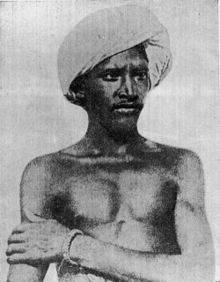Birsa Munda About this sound pronunciation (1875–1900) was an Indian tribal freedom fighter, religious leader and folk hero who belonged to the Munda tribe. He spearheaded an Indian tribal indigenous religious millenarian movement that rose in the tribal belt of modern-day Bihar and Jharkhand in the late 19th century, during the British Raj, thereby making him an important figure in the history of the Indian independence movement. His achievements are even more remarkable for having been accomplished before the age of 25.
His portrait hangs in the Central Hall of the Indian parliament, the only tribal leader to have been so honored.
His birth anniversary which falls on 15 November, is still celebrated by tribal people in as far as Mysore and Kodagu districts in Karnataka, and official function takes place at his Samadhi Sthal, at Kokar Ranchi, the capital of Jharkhand.
Today, there are a number of organizations, bodies and structures named after him, notably Birsa Munda Airport Ranchi, Birsa Institute of Technology Sindri, Birsa Munda Vanvasi Chattravas, Kanpur, Sidho Kanho Birsha University, Purulia, and Birsa Agricultural University. The war cry of Bihar Regiment is Birsa Munda Ki Jai (Victory to Birsa Munda).In 2008, Hindi film based on the life of Birsa, Gandhi Se Pehle Gandhi was directed by Iqbal Durran based on his own novel by the same name.Another Hindi film, “Ulgulan-Ek Kranti (The Revolution)” was made in 2004 by Ashok Saran, in which 500 Birsaits or followers of Birsa acted.
Ramon Magsaysay Award winner, writer-activist Mahasweta Devi’s historical fiction, Aranyer Adhikar (Right to the Forest, 1977), a novel for which she won the Sahitya Akademi Award for Bengali in 1979, is based on his life and the Munda Rebellion against the British Raj in the late 19th century; she later wrote an abridged version Birsa Munda, specifically for young readers.
(Ref:https://en.wikipedia.org/wiki/Birsa_Munda)
